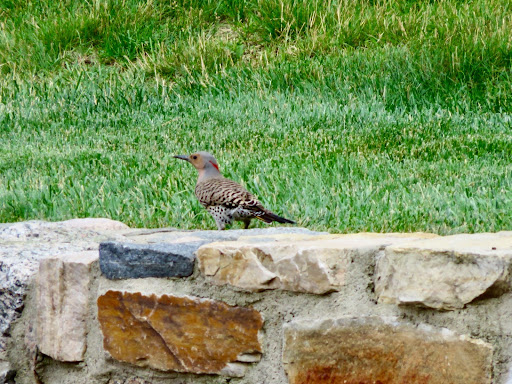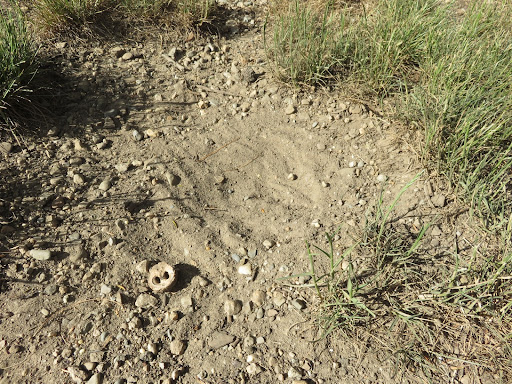Recently I witnessed a dust storm . . . a very small dust storm on the far side of Queset House. Disappointed that I had spooked a bird, I sat quietly in a less conspicuous place and amused myself by watching a gray squirrel scurry off with a black walnut. Then the bird returned and kicked up enough sand to attract the attention of any onlookers. Here she is:
The bird is a northern flicker, a large woodpecker with attractive brown, speckled plumage. When she stands upright in the video, her black bib and red nape are apparent. This is the “yellow-shafted” form which has yellow under its tail and wings . . . if we could see them. The image below shows a more typical posture with the tiniest sliver of the yellow visible at the tail.

A male bird, by the way, would have a prominent black “mustache.” They both display a conspicuous white rump in flight.
So, what’s our hyperactive bird up to? Jerking its head, kicking its feet, and fluffing its feathers, the bird is likely taking a bath. Many species including sparrows and ground-dwelling birds like quail bathe in this manner. For them, dust works like dry shampoos do for people: the powder absorbs excess oils. Removing excess oil and flakes of dry skin is important to a bird’s health because matted feathers won’t function efficiently for flight or insulation. Listen to “The Value of a Dust Bath” on BirdNote, the one-minute daily audio program, for a concise explanation. Many sources also claim that dust baths reduce the number of parasites such as mites and lice. I wouldn’t be surprised if the bird feels better after a bath.
Once the flicker departed, I examined several wallows under that same hemlock tree. Each concavity showed scrape marks like this one. She’s been here before!

Flickers are often observed on the ground, for that is where they find their favorite food: ants. According to All About Birds, ““Flickers often go after ants underground (where the nutritious larvae live), hammering at the soil the way other woodpeckers drill into wood.” Their two-inch long, barbed tongues are well adapted to securing this prey.
This brief video follows a flicker along the Queset Garden wall as she pokes for an insect meal.
While ants are the mainstay, flickers eat other insects such as beetle larvae and, in winter, fruits like dogwood and poison ivy berries.
Look for this species along forest edges where both open ground and dead trees are nearby. Northern flickers excavate their nests in dead or diseased trees, preferring wood that is “well weathered or partially rotted” according to Donald Stokes in A Guide to Bird Behavior Volume 1. These cavities are lined only with wood chips. Flicker observers should note that the birds “often return to the area of their previous nest tree” (Stokes). Indeed, “flickers often reuse cavities that they or another species excavated in a previous year” (All About Birds).
Right now, flickers are not especially visible at the Ames Free Library, but they are vocal. From the library windows, I sometimes hear the rapid “wik wik wik wik” rattle and the sharp “kleer” call. The clip below was recorded on a blustery day right outside the library’s entrance.
Let’s see:
✔ dead and damaged trees surrounded by dense shrubbery and a pond
✔ open lawn and gravel pathways nearby
Home, sweet home?